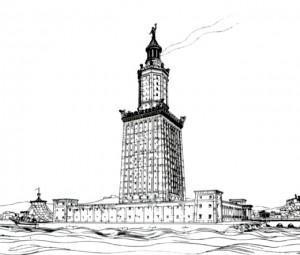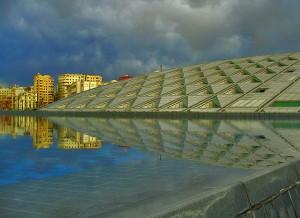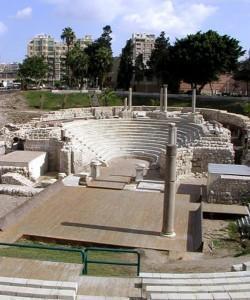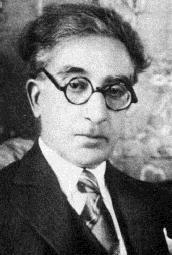Alexandria Sightseeing
They are there for every visitor of the city to enjoy. They are cultural relics of three civilizations and three religions. Our guide will explain "everything" about them, but it would help if we had an idea of what it is about beforehand.
|

|
The Pharos of Alexandria
www.uscg.mil/history/webLightHouses/Image62.gif |
Sultan Qaitbey's Fort
is located on the northern tip of the Eastern Harbor and is considered one of the most visited Alexandrian landmarks. The Fort was built in the second half of the 15th century exactly where the ancient Pharos of Alexandria had existed, before collapsing by the tremendous earthquakes of 1303 and 1323. It is believed that the Pharos, Alexandria's ancient light-house, was built in 279 BC to a height of 125 to 150 meters (375 to 450 ft) and topped with a statue of Poseidon. Today, the Fort contains a mosque and the Alexandria Naval Museum and provides wonderful views of the city and the Mediterranean Sea.
Pompey's Pillar
A 25m. (75 ft) red granite column constructed in honor of the Emperor Diocletian, originally from the Temple of Serapis, once a magnificent structure rivalling the Soma and the Caesareum. It is the tallest ancient monument in Egypt. Nearby are subterranean galleries where the sacred Apis bulls were buried, and three sphinxes.
 |
|
The New Bibliotheca Alexandrina, an imposing
Architectural and Cultural project
|
The New Bibliotheca Alexandrina
The erection of a New Bibliotheca Alexandrina, as a successor of the world renowned Ancient one, was discussed for the first time in 1974. A plot of land was selected at the seafront, close to where the ancient one existed; the idea was adopted with enthusiasm by many agencies and International Organizations, like the Unesco. An international architectural competition gave birth to some 1400 propositions. The one that was adopted was by a Norwegian office. The construction was supposed to cost 65 million USD; the total final expenditure was to rise to 220 million USD.
Construction works began in 1995; after nearly seven years the New Bibliotheca Alexandrina was inaugurated in 2002.
The Bibliotecha Alexandrina is more than merely a Library. Further to its vast shelf space (enough for 8 million books) and its 70,000 sq. meters of reading space on 11 cascading floors, it also features specialized libraries for children, for young people and for the blind. There are also 4 Art Galleries, a manuscript restoration laboratory, a planetarium and 3 museums.
There is criticism that building the Library far exceeded the finances of the country; the same is said about the annual expenses for running the establishment, let alone the cost for acquiring the books to occupy its shelf space. The collections at the Bibliotheca Alexandrina were donated from all over the world., but it is estimated that it will take longer than 80 years to fill the Library, lest the current level of funding gets generously higher.
One last piece of information: The Library, as from 2008, will host a Center for Hellenistic Studies.
The Catacombs of Al-Shuqqafa
They are considered to be the greatest Roman cemetery in Egypt, dating back to the beginning of the 2nd Century AD. They consist of three tiers at a depth of 30 meters (100 feet). It's a blend of Pharaonic and Roman art decorated with a mixture of Pharaonic and Greek motives in a rich union of these two cultures.
 |
| The Roman Theater of Alexandria |
The Roman Theater
This well-preserved Roman Theater, emcompassing galleries, marble seats for 800 spectators and mosaic floors lay under a Muslim cemetery. It took the archaeologists 30 years of hard work to unearth this monument. The Theater itself was built on the ruins of an ancient Sanctuary dedicated to Pan. At various historical eras, the theater used to host musical performances, Byzantine chariot races and gladiator contests. The northern side of the theater was possibly part of the ancient university of Alexandria.
The House of Constantine Kavafis, Great Greek Poet (1863 - 1933)
 |
|
Constantine Kavafis, one of the
most emminent Greek poets
|
Constantine Kavafis, perhaps the greatest Greek poet ever, was born in Alexandria, traveled a lot, but came back and lived there for 35 years, until his death. The house at 10, Sharm El Sheick Str. (Lepsius Str. while he was alive) has been turned into a Museum. The building used to be a cheap hostel for many decades, but lately, after great efforts and a lot of work, it was restored; part of the poet's library was saved as well. The furniture was lost, as the heirs sold it after his death, but copies were produced based on photos of them.
In the museum there are translations of the poet’s work in 20 foreign languages by 40 writers; also, more than 3000 articles and studies on his work.
A growing number scholars maintain that Kavafis has been the top poet of the last century; it would be a pity to visit Alexandreia and not pay a visit to his house, where he wrote most of his most important poetry.
|



